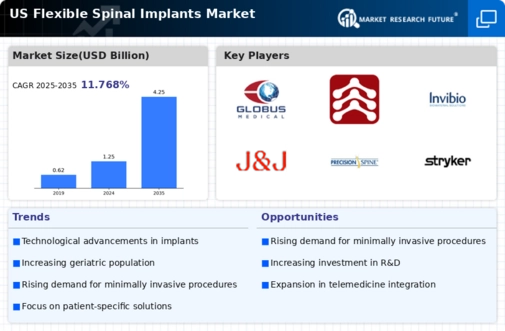Advancements in Material Science
Innovations in material science are significantly influencing the flexible spinal-implants market. The development of biocompatible materials that mimic the natural properties of spinal tissues is enhancing the performance of implants. These materials not only improve the integration of implants with the body but also reduce the risk of complications. For instance, the introduction of flexible polymers and advanced composites allows for greater adaptability and comfort for patients. The flexible spinal-implants market is witnessing a surge in research and development activities aimed at creating next-generation implants that offer superior mechanical properties. This focus on material innovation is expected to drive market growth, as healthcare professionals increasingly adopt these advanced solutions for spinal surgeries.
Rising Incidence of Spinal Disorders
The increasing prevalence of spinal disorders in the US is a primary driver for the flexible spinal-implants market. Conditions such as degenerative disc disease, scoliosis, and spinal stenosis are becoming more common, affecting millions of individuals. According to recent estimates, approximately 80% of adults experience back pain at some point in their lives, leading to a growing demand for effective treatment options. Flexible spinal implants offer innovative solutions that can enhance patient outcomes by providing better mobility and reduced recovery times. As the population ages, the incidence of these disorders is likely to rise, further propelling the market. The flexible spinal-implants market is thus positioned to benefit from this trend, as healthcare providers seek advanced technologies to address the needs of their patients.
Rising Awareness and Education on Spinal Health
The growing awareness and education regarding spinal health are driving factors for the flexible spinal-implants market. As more individuals become informed about spinal disorders and treatment options, there is an increasing demand for effective solutions. Educational campaigns and initiatives by healthcare organizations are helping to disseminate information about the benefits of flexible spinal implants. This heightened awareness is likely to lead to more patients seeking consultations and treatments for their spinal issues. The flexible spinal-implants market is thus positioned to capitalize on this trend, as healthcare providers respond to the rising demand for advanced spinal care solutions.
Growing Demand for Outpatient Surgical Procedures
The shift towards outpatient surgical procedures is a notable trend impacting the flexible spinal-implants market. Patients and healthcare providers are increasingly favoring minimally invasive techniques that allow for quicker recovery times and reduced hospital stays. Flexible spinal implants are particularly suited for these procedures, as they can be implanted with less tissue disruption. Recent data indicates that outpatient surgeries have increased by over 30% in the past few years, reflecting a broader trend in the healthcare industry. This growing preference for outpatient care is likely to drive the flexible spinal-implants market, as more patients seek effective solutions that align with their desire for convenience and faster recovery.
Increased Investment in Healthcare Infrastructure
The expansion of healthcare infrastructure in the US is a critical driver for the flexible spinal-implants market. With ongoing investments in hospitals and surgical centers, there is a greater capacity to perform advanced spinal surgeries. This infrastructure development is accompanied by an increase in the availability of cutting-edge medical technologies, including flexible spinal implants. As healthcare facilities upgrade their equipment and capabilities, the flexible spinal-implants market stands to benefit from enhanced access to innovative treatment options. Furthermore, the emphasis on improving patient care and outcomes is likely to encourage the adoption of these advanced implants, thereby fostering market growth.






















Leave a Comment